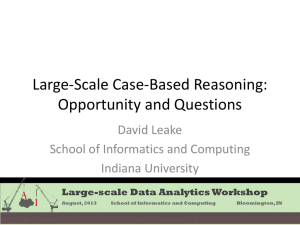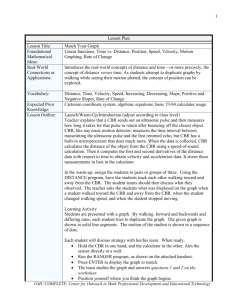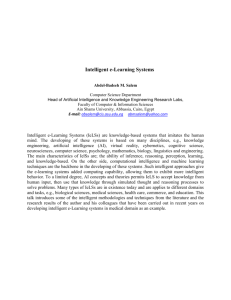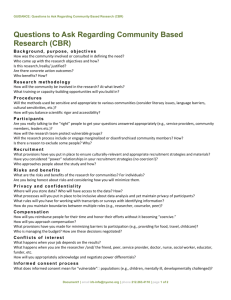Intelligent e-Learning Systems:
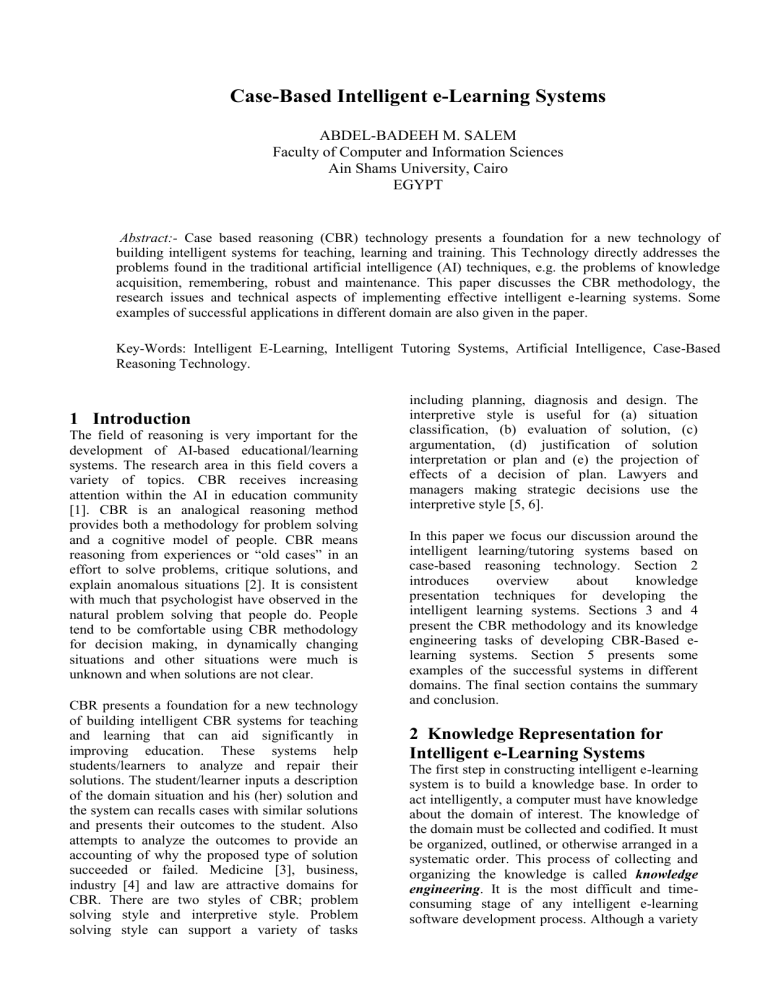
Case-Based Intelligent e-Learning Systems
ABDEL-BADEEH M. SALEM
Faculty of Computer and Information Sciences
Ain Shams University, Cairo
EGYPT
Abstract: Case based reasoning (CBR) technology presents a foundation for a new technology of building intelligent systems for teaching, learning and training. This Technology directly addresses the problems found in the traditional artificial intelligence (AI) techniques, e.g. the problems of knowledge acquisition, remembering, robust and maintenance. This paper discusses the CBR methodology, the research issues and technical aspects of implementing effective intelligent e-learning systems. Some examples of successful applications in different domain are also given in the paper.
Key-Words: Intelligent E-Learning, Intelligent Tutoring Systems, Artificial Intelligence, Case-Based
Reasoning Technology.
1 Introduction
The field of reasoning is very important for the development of AI-based educational/learning systems. The research area in this field covers a variety of topics. CBR receives increasing attention within the AI in education community
[1]. CBR is an analogical reasoning method provides both a methodology for problem solving and a cognitive model of people. CBR means reasoning from experiences or “old cases” in an effort to solve problems, critique solutions, and explain anomalous situations [2]. It is consistent with much that psychologist have observed in the natural problem solving that people do. People tend to be comfortable using CBR methodology for decision making, in dynamically changing situations and other situations were much is unknown and when solutions are not clear.
CBR presents a foundation for a new technology of building intelligent CBR systems for teaching and learning that can aid significantly in improving education. These systems help students/learners to analyze and repair their solutions. The student/learner inputs a description of the domain situation and his (her) solution and the system can recalls cases with similar solutions and presents their outcomes to the student. Also attempts to analyze the outcomes to provide an accounting of why the proposed type of solution succeeded or failed. Medicine [3], business, industry [4] and law are attractive domains for
CBR. There are two styles of CBR; problem solving style and interpretive style. Problem solving style can support a variety of tasks including planning, diagnosis and design. The interpretive style is useful for (a) situation classification, (b) evaluation of solution, (c) argumentation, (d) justification of solution interpretation or plan and (e) the projection of effects of a decision of plan. Lawyers and managers making strategic decisions use the interpretive style [5, 6].
In this paper we focus our discussion around the intelligent learning/tutoring systems based on case-based reasoning technology. Section 2 introduces overview about knowledge presentation techniques for developing the intelligent learning systems. Sections 3 and 4 present the CBR methodology and its knowledge engineering tasks of developing CBR-Based elearning systems. Section 5 presents some examples of the successful systems in different domains. The final section contains the summary and conclusion.
2 Knowledge Representation for
Intelligent e-Learning Systems
The first step in constructing intelligent e-learning system is to build a knowledge base. In order to act intelligently, a computer must have knowledge about the domain of interest. The knowledge of the domain must be collected and codified. It must be organized, outlined, or otherwise arranged in a systematic order. This process of collecting and organizing the knowledge is called knowledge engineering . It is the most difficult and timeconsuming stage of any intelligent e-learning software development process. Although a variety
of knowledge representation schemes have been developed over the years, these representation schemes share two common characteristics. First, they can be programmed with computer languages and stored in memory. Second, they are designed so that the facts and other knowledge contained within them can be manipulated by an inference system, the other major part of an intelligent elearning system. The inference system uses search and pattern matching techniques on the knowledge base to answer questions, draw conclusions, or otherwise perform an intelligent function. A brief overview of each of these schemes is presented in the following subsections.
2.1 Logic
Logic is the oldest form of knowledge representation technique. In any logical process first, information is given, statements are made, or observations are noted. These form the inputs to the logical process and are called premises. The premises are used by the logical process to create the output which consists of conclusions called inferences. With this process, facts that are known to be true can be used to derive new facts that also must be true. There are two basic types of reasoning: deductive and inductive . Both types are used in logic to make inferences from premises.
Almost any problem or argument can be put into this form for deductive reasoning purpose. In inductive reasoning a number of established facts or a premise is used to draw some general conclusion.
For a computer to perform reasoning using logic, some method must be used to convert the deductive or inductive reasoning process into a form suitable for manipulation by a computer. The result is what is known as symbolic logic or mathematical logic. It is a system of rules and procedures that permit the drawing of inferences from various premises using a variety of logical techniques. These methods are generally known as computational logic. There are two basic forms of computational logic, propositional logic and predicate logic. Since propositional logic deals primarily with complete statements and whether they are true or false, its ability to represent real world knowledge is limited. Consequently, intelligent tutoring training technology uses predicate logic instead. Predicate logic gives added ability to represent knowledge in finer detail.
2.2 Lists and Trees
Lists and trees are simple structures used for representing hierarchical knowledge. A list is a series of related items. Objects are divided into groups or classes of similar items. Their relationships are shown by linking them together.
The simplest form is one list, but a hierarchy is created when two or more related lists are combined. On the other hand, a tree is a graphical structure of hierarchy, it is simply a way of illustrating lists and other hierarchical knowledge.
2.3 Semantic Networks
Semantic networks are basically graphical depictions of knowledge that show hierarchical relationships between objects. A semantic network is made up of a number of nodes, which represent objects and descriptive information about those objects. Objects can be any physical items such as a book, car, desk, or even a person. Nodes can also be concepts, events, or actions. The nodes in a semantic network are also interconnected by link or arcs. The arcs show the relationships between the various objects and descriptive factors. Some of the most common arcs are of the is-a or has-a type.
2.4 Frames
A frame is a relatively large block or chunk of knowledge about a particular object, event, location, situation, or other element. The frame describes that object in great detail. The detail is given in the form of slots which describe the various attributes and characteristics of the object or situation. Frames are normally used to represent stereotyped or knowledge based on well-known characteristics and experiences. With frames, it is easy to make inferences about new objects, events, or situations because they provide a base of knowledge drawn from previous experience. For example, the items of the components of any automobile or the animal kingdom can be represented in frames format.
2.5 Scripts
A script is a knowledge representation scheme similar to a frame, but instead of describing an object, the script describes a sequence of events.
Like the frame, the script portrays a stereotyped situation. Unlike the frame, it is usually presented in a particular context. To describe a sequence of events, the script uses a series of slots containing information about the people, objects, and actions that are involved in the events. Some of the
elements of a typical script include entry conditions, props, roles, tracks and senes .
2.6 Production Rules
Production rules, sometimes just referred to as rules or productions, are two part statements that embody small pieces of knowledge. The first part of the rule, called the antecedent, expresses a
Input Case
3.1 CBR Algorithm
Figure (1) shows the CBR flowchart adapted from [7]. Following this diagram, the algorithm of interpreting and assimilating a new case can be summarized in the following processes:
1. Assign Indexes : where the features of the new case are assigned as indexes characterizing the event.
Indexing Rules KS
Case
Memory KS
Assign Indexes
Input + Indexes
Retrieve
Prior Solution
Modify
Proposed Solution
Similarity Rules KS
Modification Rules KS
Successful plane
Store
Succeed
Assign Indexes
Working
Solution
Test
Predictive Features
Fails
Failure
Descriptio n
Explain
Working
Solution
Repair
Revised
Solution
Repair Rules KS
Figure 1.
CBR Algorithm. Boxes represent processes and ovals represent knowledge structure (KS). situation or premise while the second part, called the consequent, states a particular action or conclusion that applies if the situation or premise is true.
3 CBR Methodology
CBR refers to a number of concepts and techniques that can be used to record and index cases and then search them to identify the ones that might be useful in solving new cases when they are presented. In addition, there are techniques that can be used to modify earlier cases to better match new cases and other techniques to synthesize new cases when they are needed [2].
2. Retrieve : where the indexes are used to retrieve a similar past case from the case memory. (The past case contains the prior solution).
3. Modify : where the old solution is modified to confo r m to the new situation, resulting in a proposed solution.
4. Test : where the proposed solution is tried out. It either succeeds or fails.
5. Assign and Store : If the solution succeeds , then assign indexes and stores a working solution.
The successful plan is then incorporated into the case memory.
6. Explain, Repair and Test : If the solution fails, then explain the failure, repair the working
solution, and test again. The explanation process identifies the source of the problem. The predictive features of the problem are incorporated into the indexing rules knowledge structure to anticipate this problem in the future. The failed plan is repaired to fix the problem, and the revised solution is then tested.
3.2 CBR Knowledge Structure
To perform the above CBR processes, the following knowledge structures (KSs) are very essential:
1.
Indexing Rules KS: These rules identify the predictive features in the input that provides appropriate indexes into the case memory.
2.
Case Memory KS : Case memory is the episodic memory, which comprises of database of experience.
3.
Similarity Rules KS : If more than one case is retrieved form episodic memory, the similarity rules (or metrics) can be used to decide which case is more like the current situation.
4.
Modification Rules KS : If no old case is going to be an exact match for a new situation, the old case must be modified to fit. We require knowledge about what kinds of factors can be changed and how to change them.
5.
Repair Rules KS : Once we identify and explain an expectation failure, we must try to alter our plan to fit the new situation. Again we have rules for what kinds of changes are permissible.
4 Knowledge Engineering
Tasks in CBR
To implement a CBR system, we had to provide answers to the following set of questions [7];
(a) What constitutes a case and what are its attributes? How is it represented?
(b) How is indexing done? What are the case similarity metrics?
(c) What is the retrieval strategy?
What constitutes a relevant case?
(d) How can old solutions be adapted? What are the modification rules?
(e) How does memory change over time?
This section discusses the CBR issues in implementing the CBR-based systems, namely;
(a) case representation, (b) case indexing, (c) case storage and retrieval, (d) case adaptation and (e) learning and generalization.
4.1 Case Representation
Determining the appropriate case features is the main knowledge engineering task in CBR systems. The case is a list of features that lead to a particular outcome (e.g. the information on a personal-loan form and whether or not the loan was granted; the information on a patient history and the associated diagnosis). The task involves;
(a) defining the terminology of the domain and (b) gathering representative examples of problem solving by the expert. Representations of cases can be in any of several forms; predicate representations, frame representations and representations resembling database entries.
Depending on what is included in a case, the case can be used for a variety of purposes:
(a) Cases that include a problem-description
AND solution can be used in deriving solutions to new problems,
(b) Cases that include a problem-description
AND outcome can be used in evaluating new situations and
(c) Cases that have a specified solution can be used in evaluating proposed solutions and anticipating potential problems before they occur.
4.2 Case Indexing Process
The CBR system derives its power from its ability to retrieve relevant cases quickly and accurately from its memory. Figuring out when a case should be selected for retrieval in similar future situations is the goal of the case indexing process . Building a structure or process that will return the most appropriate case (from the case memory) is the goal of the retrieval process . Case indexing process usually falls into one of three approaches: nearest neighbor, inductive, and knowledgeguided or a combination of the three [2].
4.3 Case Memory Organization and
Retrieval
Once cases are represented and indexed, they can be organized into an efficient structure for retrieval. Most case memory structures fall into a range between purely associative retrieval , where any or all of the features of a case are indexed independently of the other features, and purely
hierarchical retrieval , where case features are highly organized into a general-to-specific a concept structure. Nearest-neighbor matching techniques are considered associative because they have no real-memory organization. Discrimination nets are more of a cross between associative and hierarchical because they have some structure to the net but greater retrieval flexibility because they have a greater number of links between potential indexing features. Decision trees are an example of purely hierarchical memory organization. The type of memory organization is related to the amount of knowledge available to perform indexing and the retrieval needs of the system. If flexibility is required because one case library is being used for several retrieval tasks, a more associative approach is often used. When the retrieval task is well defined, a hierarchical approach is used because of the advantages in retrieval time the hierarchical approaches have over associative approaches.
4.4 Case Adaptation
It is difficult to define a single generically applicable approach to perform case adaptation, because adaptation tends to be problem specific
[2, 8]. Most existing CBR systems achieve case adaptation for the specific problem domains they address by encoding adaptation knowledge in the form of a set of adaptation rules or domain model.
Adaptation rules are then applied to a retrieved case to transform it into a new case that meets all of the input problem’s constraints. More recent applications have successfully used pieces of existing cases in memory to perform adaptations.
In problem domains where it is difficult to codify enough rule-like knowledge to let board adaptation be done, using pieces of cases is the best, if not the only alternative. And, even if cases can’t be adapted by the computer, at least the system has provided the human “adapter” with a significant starting point.
4.5 Learning and Generalization
As cases accumulates, case generalization can be used to define prototypical cases that embody the major features of a group of specific cases, and those prototypical cases can be stored with the specific cases, improving the accuracy of the system in the long run. In addition, inductive-case analysis research is being done to build domain theories in areas where even the experts don’t understand how the underlying processes in their domain work.
4.6 CBR-Shells
The availability of a commercial CBR shells in the market helps the knowledge engineers to overcome some of the problems they currently face in designing and maintaining large knowledge-base learning systems using rule based tools. The most comprehensive evaluation of commercial CBR tools from Europe and the USA have been published by Watson [9]. Most of the tools can be integrated with other model-based tools. This property suggests that including CBR as an element within our applications is now great.
The most of the currently available CBR shells are: CBR-Express, CasePoint, ART*Enterprise,
CasePower, Esteem, Expert Advisor, ReMind,
CBR/text, Eclips, ReCall, RATE-CBR, S3-Case,
INRECA, and CASUEL.
5 Examples of CBR- Based
E-Learning Systems
CBR learning system uses an extensive case-base of exercises and examples to teach students.
Research reveals that students learn best when they are presented with examples of problemsolving knowledge and are then required applying the knowledge to real situations. The case-base of examples and exercises capture realistic problemsolving situations and presents them to the students as virtual simulations. Each example/exercise includes:
(a) a multi-media description of the problem, which may evolve over time
(such as in a tactical scenario);
(b) a description of the correct actions to take including order-independent, optional, and alternative steps.
(c) a multi-media explanation of why these steps are correct;
(d) the list of methods to determine whether students correctly executed the steps;
(e) the list of principles that must be learned to take the correct action.
CBR community has begun to build
CBR systems in education. Examples of case-based educational and training systems are:
(1) Schank’s ASK systems [10] take on the role of expert and guide a user dialog in which the system tells stories to make its points.
(2) Archie-2 [11] is used in several architecture studios at Georgia Tech to help student designers with their projects.
(3) Design Muse authoring tool [12] is used in classes as well, both to build useful case libraries for several of engineering classes and to give students the opportunity to learn more about some area by preparing and indexing well-articulated cases.
(4) KONGZI automatic generation tool [13] is used for developing CBR systems of three different domains: the first system for detecting and processing faults of drills, the second for teaching diagnosis of heart diseases and the third for teaching botanical classification.
(5) CBTS [14] is used for automatic generation of educational web pages for teaching sea creatures.
(6) CANCER [15] is a prototype hybrid expert system for diagnosis of cancer disease.
The system provides recommendations for controlling pain and providing symptom relief in advanced caner. The system is useful for aiding the non expert young physicians to check their diagnosis. A new hybrid adaptation model for thyroid cancer diagnosis has been developed [16]. The model combines CBR, neural networks and certainty factors
(7) HEART [17] is a hybrid expert system prototype used for supporting diagnosis of heart diseases the system is able to give appropriate for four heart diseases namely; mitral stenosis, left-sided heart failure, stable angina pectoris and essential hypertension with the corresponding certainty factors.
6 Summary and Conclusions
1.Knowledge representation techniques offer a potentially powerful tools for the development of educational software. The variety of such techniques is enabling the design of a robust intelligent tutoring, learning and training systems. The key to the success of such systems is the selection of the knowledge representation scheme that best fits the domain knowledge and the problem to be solved. That choice is depends on the experience of the knowledge engineer.
2.The combination of AI and education results in different products of intelligent educational software for all tasks and domains. AI provides a variety of methodologies and theories about reasoning, inference and learning. Hypotheses derived from these theories can inform curriculum, pedagogy, and potential roles for computers in education and learning.
3.CBR-based e-learning systems enhance instructor/learner productivity. They also provide tailored instruction and remediation, while allowing flexibility in teaching methods, achieving many of the same benefits as one-on-one instruction.
4.CBR shells allow easy development and maintenance of training systems which are based on pedagogically sound instructional strategies. The software is domainindependent and thus useful for creating a wide array of intelligent e-learning systems for a variety of domains.
5.The convergence of AI and web technologies is enabling the creation and implementation of the intelligent internetbased training technology. Such technology will provide a unique opportunity to distribute training across multiple sites while dramatically reducing travel-related training costs. Not only do students receive training at their own sites, but instructors monitor students progress from a distance, and course authors maintain and update training material across the internet.
References:
[1] Greer, J . Proceedings of AI-ED 95 , World
Conference in Artificial Intelligence in
Education, Association for Advancement of
Computing in Education (AACE),
Washington, DC, 1995.
[2] Kolodner, J. Case-Based Reasoning, Morgan
Kaufmann, San Mateo, 1993.
[3] Silvana, Q., Pedro, B., and Steen, A.
Proceedings of 8th Conference on Artificial
Intelligence in Medicine in Europe , AIME,
Cascais, Portogal, Springer, 2001.
[4] Hinkle, D. and Toomey, C., Applying Case-
Based Reasoning to Manufacturing, AI
Magazine , pp. 65-73, 1995.
[5] Rissland, E.L. and Danials, J.J., A Hybrid
CBR-IR Approach to Legal Information
Retrival, Proceedings of the Fifth
International Conference on Artificial
Intelligence and Law , (ICAIL-95), pp. 52-61,
College Park, MD, 1995.
[6] Salem, A.M. and Baeshen, N., Artificial
Intelligence Methodologies for Developing
Decision Aiding Systems, Proceedings of
Decision Sciences Institute, 5 th International
Conference , Integrating Technology and
Human Decisions: Global Bridges into the
21 st Century (D.I.S. 99 Athens), Greece, pp.168-170, 1999.
[7] Salde, S. Case-Based Reasoning: A Research
Paradigm , AI Magazine , Vol. 12, No. 1, 42-
55, 1991.
[8] Voss, A. Towards a Methodology for Case
Adaptation, Proceedings of the 12th
European Conference on Artificial
Intelligence , Budapest, Hungary, pp. 147–
157, 1996.
[9] Ian W., Applying Case-Based Reasoning:
Techniques for Enterprise Systems , Morgan
Kaufmann, California, 1997.
[10] Ferguson, W., Bareiss, R., Birnbaum, L., and
Osgood, R. ASK systems: An approach to the Realization of Story-Based Teachers,
Journal of the Learning Sciences , 2: 95-134,
1992.
[11] Domeshek, E. and Kolodner, J. L. Using the
Points of Large Cases, Artificial Intelligence for Engineering Design , Analysis and
Manufacturing (AIEDAM), Vol. 7. No. 2, pp. 87 – 96, 1993.
[12] Domeshek, E., Kolodner, J. L., and Zimring,
C. The Desing of a Tool Kit for Case-Based
Design Aids. In Gero, J. S. & Sudweeks, F.
(Eds.), Artificial Intelligence in Design ,
Kluwer Academic Publishers, Metherlands, pp. 109-126, 1994.
[13] Lu, R., Cao, C., Chen, Y., and Han, Z. On
Automatic Generation of Intelligent Tutoring
Systems , Proceedings of the Int. Conf. Of
Artificial Intelligence in Education ,
Washington D. C., USA, 1995.
[14] Salem, A. Educational Knowledge Bases on the Web, Proceedings of the Sixth EDEN
Annual Conference on Open and Distance
Learning , Budapest, Hungary, 1997.
[15] Salem A.B.M, Roushdy M., and El-Bagoury,
B.M., An Expert System for Diagnosis of
Cancer Diseases, Proceedings of the 7 th
International Conference on Soft Computing ,
MENDEL, pp. 300-305, 2001.
[16] Abdel-Badeeh M. Salem , Bassant M. El
Bagoury, A Case-Based Adaptation Model for Thyroid Cancer Diagnosis Using Neural
Networks, Proceedings of the sixteenth international FLAIRS Conference , AAAI
Press, pp.155-159, 2003.
[17] Abdel-Badeeh M. Salem and Rania A.
HodHod, A Hybrid Expert System
Supporting Diagnosis of Heart Diseases,
Proceedings of IFIP 17th World Computer
Congress , TC12 Stream on Intelligent
Information Processing, Kluwer Academic
Publishers, Montreal, Quebec, Canada, pp.
301-305, 2002.


